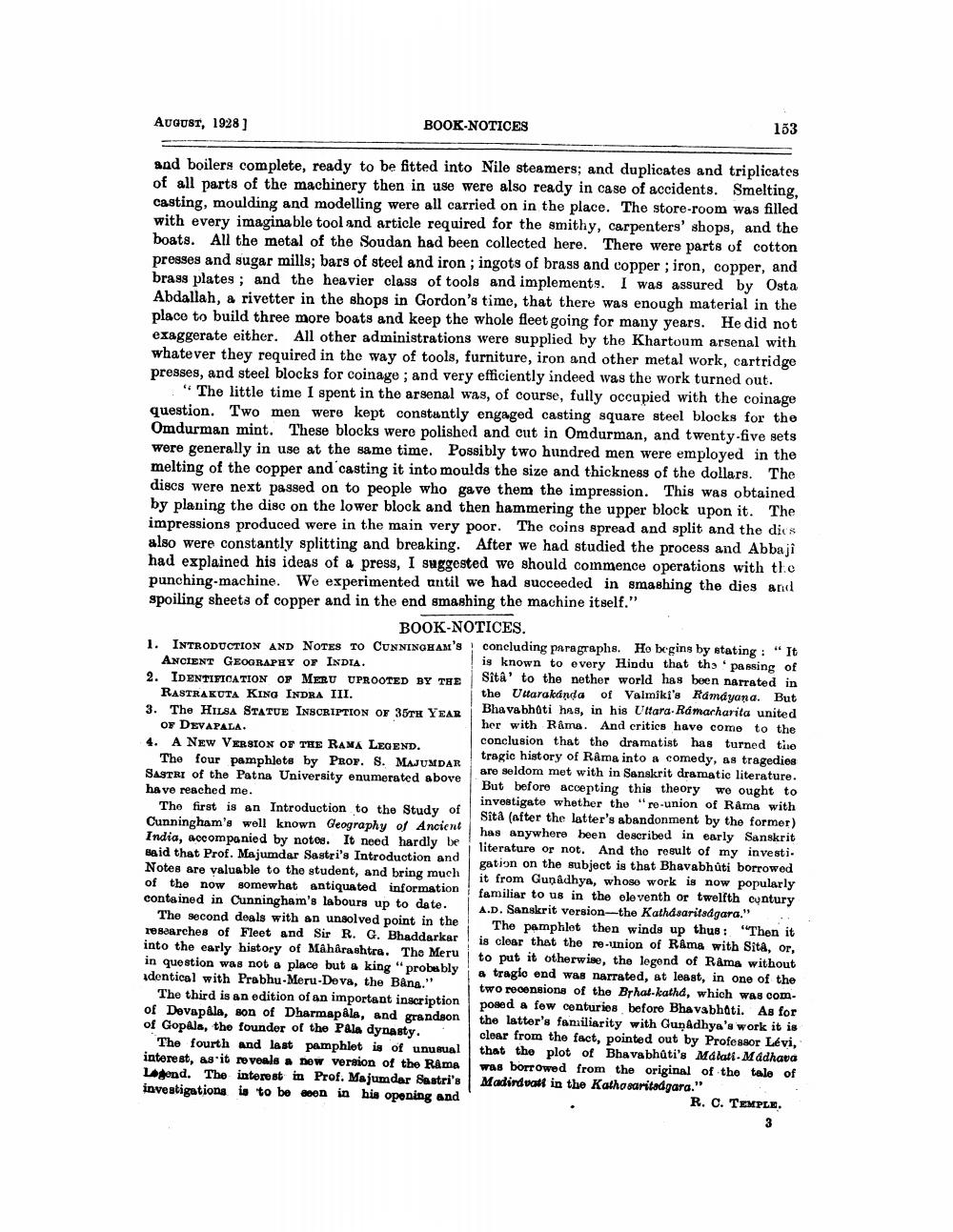________________
AUGUST, 1928)
BOOK-NOTICES
153
and boilers complete, ready to be fitted into Nile steamers; and duplicates and triplicates of all parts of the machinery then in use were also ready in case of accidents. Smelting, casting, moulding and modelling were all carried on in the place. The store-room was filled with every imaginable tool and article required for the smithy, carpenters' shops, and the boats. All the metal of the Soudan had been collected here. There were parts of cotton presses and sugar mills; bars of steel and iron ; ingots of brass and copper ; iron, copper, and brass plates, and the heavier class of tools and implements. I was assured by Osta Abdallah, a rivetter in the shops in Gordon's time, that there was enough material in the place to build three more boats and keep the whole fleet going for many years. He did not exaggerate either. All other administrations were supplied by the Khartoum arsenal with whatever they required in the way of tools, furniture, iron and other metal work, cartridge presses, and steel blocks for coinage, and very efficiently indeed was the work turned out.
"The little time I spent in the arsenal was, of course, fully occupied with the coinage question. Two men were kept constantly engaged casting square steel blocks for the Omdurman mint. These blocks were polished and cut in Omdurman, and twenty-five sets were generally in use at the same time. Possibly two hundred men were employed in the melting of the copper and casting it into moulds the size and thickness of the dollars. The discs were next passed on to people who gave them the impression. This was obtained by planing the disc on the lower block and then hammering the upper block upon it. The impressions produced were in the main very poor. The coins spread and split and the dics also were constantly splitting and breaking. After we had studied the process and Abbaji had explained his ideas of a press, I suggested we should commence operations with the punching machine. We experimented until we had succeeded in smashing the dies and spoiling sheets of copper and in the end smashing the machine itself."
BOOK-NOTICES. 1. INTRODUCTION AND NOTES TO CUNNINGHAM'S concluding paragraphs. Ho begins by stating : "It ANCIENT GEOGRAPHY OF INDIA.
is known to every Hindu that the passing of 2. IDENTIFICATION OF MERU UPROOTED BY THE
Sita' to the nether world has been narrated in RASTRAKUTA KING INDRA III.
the Uttarakanda of Valmiki's Ramayana. But 3. The HILSA STATUE INSCRIPTION OF 35TH YEAR
Bhavabhati has, in his Uttara. Ramacharita united OF DEVAPALA.
her with Rama. And critics have come to the 4. A NEW VERSION OF THE RAMA LEGEND.
conclusion that the dramatist has turned the The four pamphlets by PROF. S. MAJUMDAR
tragic history of Rama into a comedy, as tragedies
are seldom met with in Sanskrit dramatic literature. SASTRI of the Patna University enumerated above
But before accepting this theory we ought to have reached me.
investigate whether the "re-union of Råma with The first is an Introduction to the Study of
Sità (after the latter's abandonment by the former) Cunningham's well known Geography of Ancient
has anywhere been described in early Sanskrit India, accompanied by notes. It need hardly be
literature or not. And the result of my investi. said that Prof. Majumdar Sastri's Introduction and
gation on the subject is that Bhavabh úti borrowed Notes are valuable to the student, and bring much of the now
it from Gunadhya, whose work is now popularly somewhat antiquated information familiar to us in the eleventh or twelfth cuntury contained in Cunningham's labours up to date.
A.D. Sanskrit version---the Kathasaritadgara." The second deals with an unsolved point in the The pamphlet then winds up thus: "Then it researches of Fleet and Sir R. G. Bhaddarkar is clear that the reunion of Rama with Sita, or. into the early history of Maharashtra. The Meru to put it otherwise, the legend of Rama without in question was not a place but a king "probably
a tragio end was narrated, at least, in one of the identical with Prabhu-Meru-Deva, the Båna."
two recensions of the Brhat-kathd, which was comThe third is an edition of an important inscription
posed a few centuries before Bhavabhäti. As for of Devapala, son of Dharmapala, and grandson the latter's familiarity with Gunadhya's work it is of Gopala, the founder of the Pala dynasty. . clear from the fact, pointed out by Professor Lévi,
The fourth and last pamphlet is of unusual that the plot of Bhavabhūti's Málati-Madhava interest, as it reveals a new version of the Rama was borrowed from the original of the tale of Lagond. The interest in Prof. Majumdar Sastri's Madirdvart in the Katho saritadgara." investigations is to be seen in his opening and
R. C. TEMPLE.




